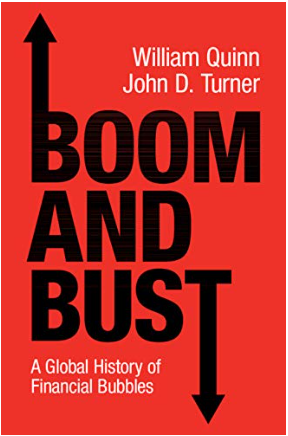
Boom and Bust: A Global History of Financial Bubbles
Why do stock markets and housing markets sometimes experience amazing booms followed by massive busts and why does this seem to be happening more and more frequently? To help answer these questions, the authors of this book take us on a fascinating journey through the history of 11 of the most interesting financial bubbles in the last 300 years, explaining the prevailing social and economic conditions that prevailed at the time and visiting, among other places, Paris and London in 1720, Latin America in the 1820s, Melbourne in the 1880s, New York in the 1920s, Tokyo in the 1980s, Silicon Valley in the 1990s and Shanghai in the 2000s. As they do so, they help us understand why bubbles happen, and why some have catastrophic economic, social and political consequences whilst others have actually benefited society. They reveal that bubbles start when investors and speculators react to new technology or political initiatives, showing that our ability to predict future bubbles will ultimately come down to being able to predict these sparks.
The authors use Kindleberger’s definition of a bubble: “upward price movement over an extended range that then implodes” and the analogy of a fire to describe speculative bubbles. A fire is destructive, self-perpetuating and difficult to control once it begins. Just as a fire needs oxygen, fuel and heat, a speculative bubble needs assets that are easy to trade (oxygen), plenty of money and credit (fuel), and speculation (heat). It also needs a spark, which usually comes from government action or new technology. Whilst conformity to the analogy is not perfect in all cases, the authors’ approach does provide great insight into common characteristics in the build-up and bursting of financial bubbles throughout history and how these key elements played out in 11 speculative booms since the 1700s:
• French Mississippi Bubble (1719 to 1720)
• British South Sea Bubble (1719 to 1720)
• British Emerging Market Mines Bubble (1824 to 1826)
• U.K. Railway Mania (1844 to1846)
• Australian Land Boom (1886 to 1893)
• The U.K. Bicycle Mania (1895 to 1898)
• U.S. Roaring Twenties (1920 to 1931)
• Japanese stock and real estate bubble (1985 to 1992)
• U.S. Dot-Com Bubble (1995 to 2001)
• U.S. and European Subprime Bubble (2003 to 2010)
• the 2007 and 2015 Chinese stock bubbles.
Some of the many interesting facts they uncover include:
• The word “bubble” originated from Shakespeare in the ‘All the world’s a stage’ speech from his comedy As You Like It. He uses ‘bubble’ to mean “fragile, empty or worthless, just like a soap bubble.” Beginning in 1719, with the South Sea Bubble, writers like Daniel Defoe and Jonathan Swift used bubble to describe new companies that were worthless.
• Charles Mackay’s 1841 book Extraordinary Popular Delusions and the Madness of Crowds gives a vivid account of the foolish speculation during the South Sea Bubble, but it is mostly fiction: almost none of the anecdotes can be substantiated.
• In 2008 The Economist described the British Railway Mania as “arguably the greatest bubble in history.”
• During the British Railway Mania of 1848, railway shares rose from constituting 23 percent of total stock market value to 71 percent. So many new speculators began buying railway stocks that 15 new stock exchanges opened in England during the mania to meet the demand. (Half of them shut down when the mania ended.)
• Fueling the railway bubble was the Bank of England’s low discount rate. At 2.5 percent in 1844, it was the lowest it had ever been in the 150 years of the bank’s history. Investors bought railway stocks to earn a higher yield.
• The Japanese government deliberately sparked the land and stock bubbles during the late 1980s to create a boom. Japan lowered interest rates, gave tax breaks to real estate developers, and allowed banks to accept land as collateral, which increased the amount of lending they could do, which was usually plowed back into more land or stocks.
• The authors believe that the Dot-com bubble during the late 1990s had many good economic benefits, despite the 8-month recession that followed it. The bubble directed a lot of money into innovative companies and motivated smart entrepreneurs to create new companies. It also supplied the capital needed to build internet communications, which have been so critical for our lives today.
• Between 2000 and 2008 in both Ireland and Spain, more than one new home was built for every new inhabitant in the country.
• In the U.K., the bank Northern Rock marketed “Together mortgages,” which allowed individuals to borrow up 125 percent of their home value, targeting borrowers who could not afford to buy a home or even furnish it.
• The Chinese stock market bubbles resembled the South Sea and Mississippi bubbles of 1720, where the bubbles were created deliberately to offload government debt into stockholders.
While it is not always clear as to the cause and effect of each bubble on the stock market from 1720 until the 21st century, the central idea is clear: most of them are man-made and fired by the necessity of the main players and the psychology of the crowd. The authors provide a bright and vivid description of every major crisis on the stock market in this book although there are few revelations and little guidance on how to recognise a bubble although it does helps us to think, analyse and be on good terms with the reasons, which I like.
Robin Sellers
April 2022
